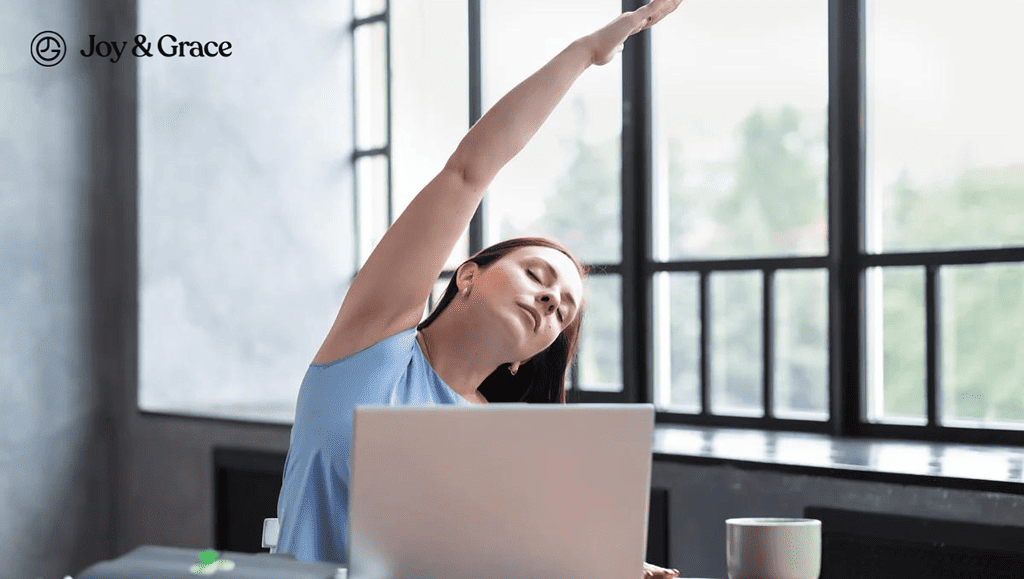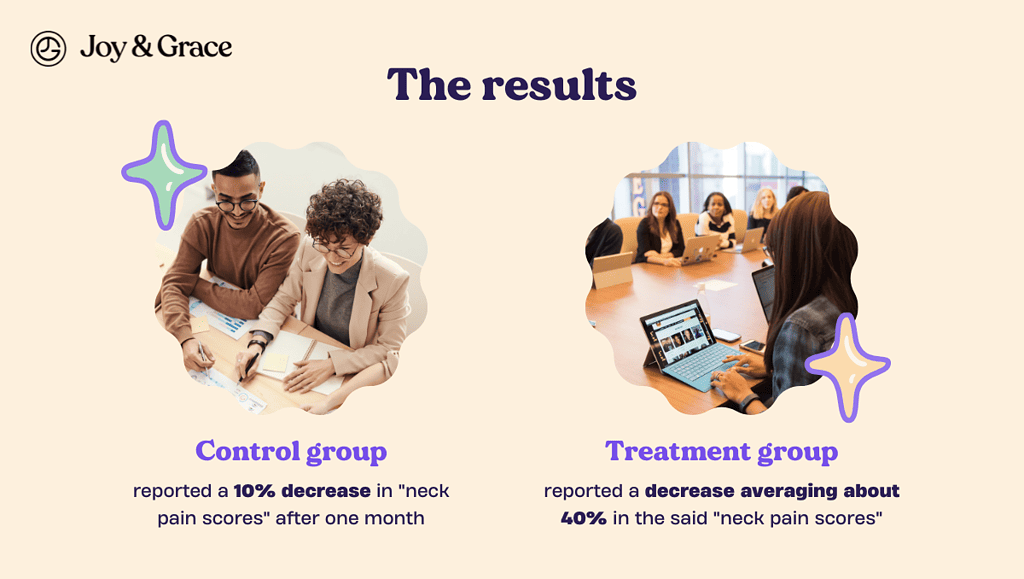If you spend most of your day sitting at a desk, it's common to experience neck pain and stiffness. Poor posture and prolonged periods of inactivity can contribute to muscle tension and discomfort. However, there are simple stretches that can help alleviate neck pain and improve flexibility.
In this article, we will provide a list of stretches specifically designed for office workers to do at their desks. These stretches can help reduce muscle tension, improve circulation, and increase range of motion. Adding these stretches to your daily routine can make a big difference in how comfortable you are and how much you get done at work.
What Can Help the Shoulder and Neck Pain You Get from Sitting at Your Desk?

There are a few things that can help alleviate shoulder and neck pain from sitting at a desk for long periods of time.
Generally, three things that seem to help the most in avoiding shoulder and neck pain from sitting at a desk are:
- Stretches
- Proper ergonomics
- Exercises outside of the office
Stretches

Many clinical studies have proven the effectiveness of stretches for neck pain in office workers.
One particular study was a randomized trial conducted at the Rehabilitation Medicine Department of Siriraj Hospital in Thailand.
The study aimed to find if there would be an improvement in neck pain scores of office workers after a regimen of daily neck stretches for one month. These mentioned “neck pain scores” were measured using standardized clinical questionnaires.
The worse the neck pain, the higher the “neck pain score.”
The inclusion criteria for the study were office workers with moderate to severe neck or shoulder pain for more than three months.
All of the participants got a brochure that showed them the right way to sit and work in the office every day.
But only about half of the participants were told by a rehabilitation doctor to do neck and shoulder stretching exercises. They were also shown how to sit and work properly.
This group was called the “study (treatment) group” by the authors.
The "control group" was the group that only got proper position and ergonomics instructions.
The stretching exercises included 20–30 repetitions per session of:
- Neck stretching,
- Shoulder stretching,
- Rolling the shoulders,
- Trunk stretching, and
- Back extension.
Each session lasted about 10–15 minutes. Two sessions were prescribed daily, five days a week, for a four-week duration.
The results: After four weeks, the "control group" and "treatment group" scores for neck pain were compared to see if there had been any improvement.

A quick reminder that the “control group” was solely instructed on proper ergonomics. The “treatment group” was additionally instructed to perform daily stretching exercises.
The “control group” reported a 10% decrease in “neck pain scores” after one month.
The “treatment group,” on the other hand, reported a decrease averaging about 40% in the said “neck pain scores.”
The conclusion? Neck stretching exercises truly work. They’re an effective treatment option for reducing pain and improving function and quality of life for office workers with neck pain.
We will extensively talk about the right way to do neck pain-alleviating stretches later on throughout the article.
Proper Ergonomics

Earlier, we mentioned how a study introduced proper ergonomics in a work office. After one month, the study found a 10% decrease in neck pain scores in office workers. So, paying attention to your sitting posture and how your whole workstation is set up is also important. Here is a brief overview of tips on proper ergonomics.
The Chair
- Choose a chair that fits the curves of your spine.
- Change the height of your chair so that your feet are flat on the floor or on a footrest and your thighs are parallel to the floor.
- Change the armrests so that your shoulders can relax and your arms can rest gently on them.
Mouse and Keyboard
- Put your mouse close to your keyboard and on the same level as the keyboard.
- When you type or use your mouse, your wrists should be straight, and your upper arms should be close to your body. Your hands should be at (or just below) the level of your elbows.
- Use keyboard shortcuts to cut down on how much you use the mouse.
- Change the mouse's sensitivity so you can move it with a lighter touch.
- You can try switching the hands which you normally use to move the mouse. You can do this by moving the mouse to the other side of the keyboard.
Desk
- Make sure there's enough space under the desk for your knees, thighs, and feet.
- Put boards or blocks under the legs of the desk, if the top of the desk is too low and can't be raised or lowered.
- Raise your chair if the desk is too high and can't be moved.
- Use a footrest to support your feet when you need to.
- If your desk has a hard edge, you can pad the edge or use a wrist rest.
- Don't store items under your desk.
Monitor
- Put the monitor right in front of you, about the length of your arm away.
- The top of the screen should be about eye level or a little bit below.
- Your keyboard should be right in front of the monitor.
- If you have bifocals, move the monitor down another 1 to 2 inches to make it easier to see.
- Put your monitor so that the light source that gives off the most light is to the side.
Objects And Tools
- Keep important things like your phone, stapler, and printed materials close to you, so you don't have to reach as much.
- Get up to reach things that are hard to get to while sitting.
Exercising Outside Of The Office
Regular exercise and stretching outside of work can help in more ways than one.
Regular exercise can help prevent muscle tension and improve muscle strength and flexibility. So, in the long run, regular exercise can make shoulder and neck pain less likely to occur.
A study of 180 female office workers with chronic neck pain found that one year of strength training the neck with elastic bands or endurance training led to significant improvements in health-related quality of life, as measured by a clinical questionnaire.
The group that worked on neck strength reported significant changes in many parameters, such as:
- Increased vitality
- Less discomfort
- Less distress
- Feeling less depressed
- Better mental function
That is very important because stress, depression, and anxiety are also important factors for people with chronic neck pain.
So, it would be reasonable to point out that a general improvement in quality of life is very important when trying to prevent or alleviate neck pain.
Neck and upper body training could achieve just that, helping those with neck pain who are motivated to exercise regularly and want to improve their health and quality of life.
How To Stretch Your Neck And Shoulders At Work
Neck and shoulder stretches are very simple and easy to do. A proper way of stretching also includes stretches of the lower back and thighs. That is done because a tense lower back can eventually cause the neck and shoulder to feel heavy and painful as well.
Here are some useful stretches for office workers and how they’re performed. This stretching routine is also recommended by Mayo Clinic.
Shoulder Stretches
Shoulder stretches are performed like this:
- Place one hand under the opposite elbow.
- Use your hand to pull that opposite elbow up and across your chest. Don't turn your body while you're stretching.
- The stretch should be held for 30 seconds. You should start feeling tension in the back of your shoulder.
- Relax and slowly move back to where you started.
- Stretch the other arm in the same way.
Upper Arm Stretches
To stretch your upper arm and shoulder from the back:
- Bend and lift one arm to touch the upper part of your back with it.
- Put your other hand on the bent & lifted elbow to help stretch your shoulder and upper arm.
- Hold the stretch for about 30 seconds.
- Slowly move back to where you started.
- Stretch the other arm the same way.
Chest Stretches
To stretch your chest muscles:
- Put your hands behind your head.
- Pull your elbows as far back as you can. Squeeze your shoulder blades together.
- Keep this position for 30 seconds.
- Relax and slowly move back to where you started.
- Repeat.
Chin Tucks
Try the chin tuck to relax your stiff neck and shoulder muscles:
- Look straight ahead.
- Pullyour chin down to your chest.
- Hold the stretch for 30 seconds. You will start feeling pressure in the back of your neck.
- Remain calm and slowly revert to your starting position.
- Repeat.
Head Turns
By turning your head to the side, you can also loosen up your neck muscles:
- Look directly ahead.
- Keep your shoulders straight while turning your head to one side.
- For 30 seconds, maintain the stretch. Your shoulder and side of your neck will feel tense.
- Remain calm and move slowly back to your starting position.
- Repeat the stretch while turning your head to the opposite side.
Side Neck Stretches
To stretch the muscles of the side of your neck:
- Look directly forward.
- Move your ear toward your shoulder by tilting your head. Refrain from raising your shoulder.
- Hold the stretch for 30 seconds. You will start to feel pressure on the side of your neck.
- Gently go back to your starting position.
- Repeat the stretch by turning your head to the opposite side.
Lower Back Stretches
As we mentioned earlier, a tense lower back could cause neck and shoulder discomfort as well.
In order to stretch your lower back:
- Sit in your chair and lean forward a little.
- Lift one of your knees and bring it up toward the chest. Use both hands to gently pull the back of your thigh towards you. Maintain a straight back and avoid bending forward.
- For 30 seconds, maintain the stretch. You'll feel stress in your upper buttock and lower back.
- Remain calm and go gently back to your starting position.
- With the opposite leg, repeat the stretch.
Standing Thigh Stretches
Consider performing some standing stretches as well. To extend your thigh's front:
- Stand up straight and put one hand on a chair or desk to stabilize yourself.
- Lift one of your ankles or lower leg and raise it up toward your buttock. Grab it to lift your leg up more. Remember to stay upright, with your back straight and your knees in line with each other.
- Maintain the stretch for 30 seconds.
- Remain calm and go gently back to your starting position.
- With the opposite leg, repeat the stretch.
Why Do Office Workers Get Neck Pain?
Office workers often report neck problems, especially those who use computers. That is no surprise.
However, most studies agree that work-related neck problems are not caused by a single cause.
Instead, current studies suggest that more neck problems are caused by a complex set of personal, physical, and social factors.
Individual Factors
- Female gender - The number of women office workers reporting neck pain is somewhat higher than that of men. Studies suggest that this may be due to a smaller stature (on average) and lower strength of the shoulder muscles.
- Not being physically active - This increases the likelihood of having neck pain. Some authors suggest that to reduce musculoskeletal problems in general, employers should stimulate physical activity during leisure time. That may minimize musculoskeletal discomfort in the working population, particularly sedentary workers.
Work-Related Physical Factors
- Holding the neck in a forward-bent posture and working in the same position for a prolonged time:
Both are significantly associated with an increase in neck pain. - Making the same movements per minute:
Most of the time, the muscles in your neck and shoulders have to act as stabilizers when you work with your hands and fingers. To keep the arms at right angles, which is necessary when using a keyboard, the trapezius and other shoulder muscles must stay tight.
This, in turn, seems to increase the risk of neck and shoulder pain in office workers.
- Sitting posture - Researchers have found a strong link between how you sit and neck pain.
Authors Ariëns et al. found that workers who sat for more than 95% of their work time were twice as likely to have neck pain compared to those who rarely sat at work.
Additional studies by Ortiz-Hernandez et al. found that sitting for a long time, which usually makes the spine curve, puts more pressure on the discs, ligaments, and muscles in the spine.
- Computer working time - Analyses of the relationship between neck pain and physical factors at work showed that neck pain was strongly linked to time spent working on a computer.
Just as a quick reminder:
Earlier in the article, we mentioned some quick and easy tips on how to set up your workspace properly.
Concrete data support that there’s an increase in neck pain if you don’t sit and organize your workspace correctly. So, we would really recommend a quick glimpse at the “proper ergonomics” part of the article just above from here.
Work-Related Psycho-Social Factors
Many different psychological and social factors at work have been reported to be associated with neck pain. However, some studies suggest that two factors seem to be more strongly linked:
- Mental tiredness at the end of the day
- Shortage of personnel
Both of these factors may be an indirect reflection of work (over) load.
That’s why rest breaks are so important. Breaks let you spend less time in front of the computer and give you time to stretch and relax your muscles.
“Tech Neck,” “Mouse Shoulder,” And “Computer Neck Syndrome”

You may have heard of these terms or noticed them while browsing.
However, these are not true medical terms. They’re simply used to express that when people use phones, tablets, and computers, they strain their muscles, which leads to pain, stiffness, and soreness in their necks and shoulders.
And the proper prevention and treatment plan for all these is the same as earlier:
- Stretches
- Proper ergonomics
- Exercises outside of the office
We’ve extensively written about how these could be achieved earlier in the article.
Takeaway
In summary, the office can be a pain in the neck, but with the right tools and techniques, you can say goodbye to that nagging discomfort.
Whether it's incorporating easy stretches into your daily routine, optimizing your workspace for optimal posture, or incorporating regular exercise outside of the office, there are plenty of ways to keep your neck happy and healthy.
So, let's give that pain the old heave-ho and get back to being productive and happy!















